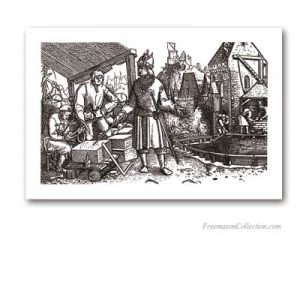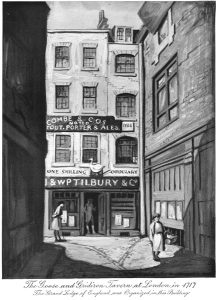The questions of when, how, why and where Freemasonry originated are still the subject of intense speculation. The general consensus amongst Masonic scholars is that it descends directly or indirectly from the organisation of operative stone masons who built the great cathedrals and castles of the middle ages.
You can find out much more about its history at the United Grand Loge of England Website.
At that time “operative” masons were those who worked on building those monuments and castles and used the “working tools” associated with the trade.

Operative Masons Lodge in the middle ages.
As a new operative mason you were an “Apprentice” and had to learn your trade over many years before you became a “Master Mason” or “free”, hence Freemason.
These masons erected “lodges” on the sites they worked at to eat, sleep and get together, and in order to prevent non-mansons entering them, especially by night, had a system of passwords and handshakes or “grips”, in order to recognise each other by and to determine the level of that masons qualification. Each level had a different “grip”.
Speculative Masonry
At some point non-masons were either
allowed into these Lodges or more likely formed their own, and these man were known as “speculative” masons.
These speculative masons used the tools and other aspects of operative masons to represent morale guidance and those became the basis of modern Freemasonry as we know it today.
Initiation
The first recorded initiation of a speculative mason was in 1646 when Elias Ashmole wrote.
October 16, 4.30pm – I was made a freemason at Warrington in Lancashire with Colonel Henry Mainwaring [a Roundhead parliamentarian friend related to his father-in-law] of Karincham in Cheshire. The names of those that were then at the Lodge, Mr Richard Penket Worden, Mr James Collier, Mr Richard Sankey, Henry Littler, John Ellam, Richard Ellam and Hugh Brewer.’
Obviously the members he mentions above would have been initiated before him, however there was no record of those found.
Grand Lodge
Then in 1717 four Lodges met together at the Goose and Gridiron Public house at St Paul’s. Those Lodges were named after the Pub’s where they met.

The Goose and Gridiron Public House.
- Goose and Gridiron Ale-house in St. Paul’s Church-yard;
- Crown Ale-house in Parker’s Lane near Drury’s Lane;
- Apple Tree Tavern in Charles Street, Covent Garden;
- Rummer and Grapes Tavern in Channel Row, Westminster.
These four Lodges then declared themselves the Grand Lodge. The first in the World.